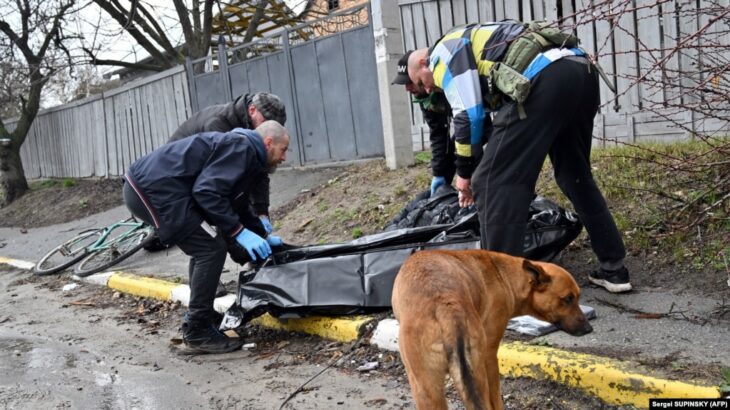
On March 11, the commander of an artillery unit belonging to Russia’s famed 76th Guards Air Assault Division died in combat in the Ukrainian town of Bucha.
Captain Gennady Bayur was killed, according to a death announcement published some two weeks later in a chat room of the social-media site VK, in a land-mine explosion in the town northwest of Kyiv. He had commanded the 234th Guards Air Assault Regiment.
Another Russian soldier, from the 64th Separate Motorized Rifle Brigade, lost his mobile phone or had it taken from him when he was killed. According to Ukrainian intelligence, which published a screenshot of the phone, it was found in Bucha; a number linked to the phone matches up to a social-media account located in the brigade’s home base.
Bucha is a crime scene.
Increasingly, it is also a worldwide synonym for atrocities that may have been committed by Russian troops during the first six weeks of their assault on Ukraine.
Days after Russian forces withdrew from Bucha, workers are struggling to clear the bodies of dozens, possibly scores of civilians from the town’s streets, from hastily dug mass graves, and from building basements, and to give them a proper burial. An unknown number of the civilian corpses show signs of having been summarily executed, with hands bound behind their backs. Some had gunshot wounds to their heads.
Ukrainian and Western investigators, meanwhile, are struggling to compile evidence and take witness accounts, as the government pledges to prosecute what it says are war crimes.
RFE/RL reporters, scouring through social-media posts, public lists of dead soldiers, video footage from the devastated town, and other information, have sought to pinpoint some of the military units that were known to have occupied Bucha between the start of the invasion on February 24 and April 1, when it was reclaimed by Ukrainian forces.
What Happened In Bucha?
The presence of Russian military units in Bucha, and other Ukrainian towns and cities they have occupied, is not proof that war crimes were committed, and investigators may be hard-pressed to accumulate conclusive, air-tight proof that could withstand scrutiny in a court or tribunal.
But in the case of Bucha, information that has already come to light — photographs, videos, eyewitness accounts — plus the fact that the town was under Russian military control for more than a month, provides strong circumstantial evidence pointing to Russian culpability.
Bucha’s mаyor, Anatoliy Fedoruk, posted a video on March 31 in which he said the town had been recaptured by Ukrainian forces following a Russian withdrawal. It wasn’t immediately clear if Russian troops had left on March 31 or earlier. The Ukrainian military said its forces entered Bucha on April 1.
On April 3, Oleksiy Arestovych, an adviser to Ukrainian President Volodymyr Zelenskiy, published a list of Russian units, both military and National Guard, that he said had been deployed to Bucha and two other towns in the Kyiv region, Irpin and Hostomel.
Among those he named were the 104th and 234th Airborne Assault Regiments of the 76th Airborne Assault Division.
Based in the northwestern Russian city of Pskov, the division is renowned in Soviet and Russian military history, for both battlefield prowess and brutality. During the Second Chechen War in the early 2000s, paratroopers from the 76th Airborne Division were credibly accused of killing Chechen civilians indiscriminately.
The social-media post about the death of Bayur, the commander of the artillery unit, was one piece of evidence pointing to the presence of the paratroopers in Bucha.
Sometime around March 26, a video apparently produced by Ukraine’s military intelligence agency appeared online, featuring a captured soldier whose unit is identified as the 76th Airborne Division. The video was later removed by YouTube but a copy was published on a Ukrainian journalist’s Telegram channel.
In the video the soldier, who is identified as Timofei Bobov, describes how on February 24 his unit was ordered to Ukraine and deployed to “clean up Hostomel or Bucha.” According to Bobov, he was instructed to break into apartments in residential buildings with a crowbar and take the people who were inside to the basement. He did not indicate what happened to them afterward.
RFE/RL could not independently verify the video, but there have been press reports from Bucha from witnesses who say their apartment doors were pried open with crowbars and relatives taken away by Russian soldiers. There is also footage of bodies in basements.
n a video published by AP on April 3 from Bucha, a discarded wooden ammunition box is briefly shown. The box has marking on it indicating it belonged to the 7th Airborne Assault Company, 234th Regiment, 76th Airborne Division.
Cell Phone, Instagram Account
Another unit identified by Arestovych as occupying some of the towns northwest and east of Kyiv is the 64th Separate Motorized Rifle Brigade, whose headquarters is in the Khabarovsk region, on the Pacific coast in Russia’s Far East.
On April 3, a Telegram channel that appears to have links to Ukraine’s military published a screenshot from a Russian soldier’s phone, describing it as “a phone of one of the occupiers of Bucha [that] was found.”
The screenshot showed an Instagram account with a phone number that RFE/RL was able to trace to a 29-year-old Khabarovsk resident. RFE/RL was unable to determine whether the man was part of the 64th Brigade, but photographs from the man’s social-media friends and acquaintances show soldiers from the 64th Brigade.
Ukraine’s military intelligence agency later published a list with hundreds of names, and other identifying information, of officers and soldiers from the 64th Brigade. That list could also not be independently confirmed.
Belarus Deployment
Other units known to have occupied some of the towns north of Kyiv include another paratrooper unit: the 331st Guards Airborne Regiment of the 98th Division, based in Kostroma, northeast of Moscow. The regiment’s commanding officer, Colonel Sergei Sukharev, was killed on March 13, and was posthumously awarded military honors. It was unclear exactly where and how he died, however.
The Defense Ministry in Belarus — from which many of the Russian units that were sent toward Kyiv entered northern Ukraine — also reported on a ceremony involving the 331st Airborne Regiment on January 25, a full month before the war began.
On February 28, meanwhile, a photograph of a list of soldiers killed in Bucha, from a unit identified as the “2nd Squad of the 2nd Platoon” appeared on another Telegram channel titled Search For Your Own. The channel is filled with photographs of Russian soldiers who have been killed or taken prisoner in Ukraine.
RFE/RL traced one of the names on the list of killed solders to a social-media profile that suggests the soldier served in the 56th Guards Air Assault Regiment, headquartered in Russia’s Volgograd region.
Amid mounting international outcry and condemnation of Moscow, the Russian authorities have denied that Russian troops were involved in the killing of civilians in Bucha or other Kyiv region towns. Without providing evidence, Russian officials have claimed photographs and footage widely distributed by Ukrainian and Western media were staged.
Kremlin spokesman Dmitry Peskov has suggested, also without evidence, that the images showed signs of being faked, and that the timing of the retreat from Bucha means that Russian soldiers could not have been responsible. That statement is contradicted by eyewitness reports from Bucha.
The U.S.-based group Human Rights Watch also collected evidence and interviews with residents of Bucha, concluding that there were “obvious war crimes” committed in districts controlled by Russian forces.





